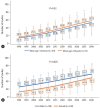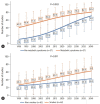Forecasted 2040 global prevalence of nonalcoholic fatty liver disease using hierarchical bayesian approach
- PMID: 36117442
- PMCID: PMC9597215
- DOI: 10.3350/cmh.2022.0239
Forecasted 2040 global prevalence of nonalcoholic fatty liver disease using hierarchical bayesian approach
Abstract
Background/aims: Due to increases in obesity and type 2 diabetes, the prevalence of nonalcoholic fatty liver disease (NAFLD) has also been increasing. Current forecast models may not include non-obese NAFLD. Here, we used the Bayesian approach to forecast the prevalence of NAFLD through the year 2040.
Methods: Prevalence data from 245 articles involving 2,699,627 persons were used with a hierarchical Bayesian approach to forecast the prevalence of NAFLD through 2040. Subgroup analyses were performed for age, gender, presence of metabolic syndrome, region, and smoking status. Sensitivity analysis was conducted for clinical setting and study quality.
Results: The forecasted 2040 prevalence was 55.7%, a three-fold increase since 1990 and a 43.2% increase from the 2020 prevalence of 38.9%. The estimated average yearly increase since 2020 was 2.16%. For those aged <50 years and ≥50 years, the 2040 prevalence were not significantly different (56.7% vs. 61.5%, P=0.52). There was a significant difference in 2040 prevalence by sex (males: 60% vs. 50%) but the trend was steeper for females (annual percentage change: 2.5% vs. 1.5%, P=0.025). There was no difference in trends overtime by region (P=0.48). The increase rate was significantly higher in those without metabolic syndrome (3.8% vs. 0.84%, P=0.003) and smokers (1.4% vs. 1.1%, P=0.011). There was no difference by clinical/community setting (P=0.491) or study quality (P=0.85).
Conclusion: By 2040, over half the adult population is forecasted to have NAFLD. The largest increases are expected to occur in women, smokers, and those without metabolic syndrome. Intensified efforts are needed to raise awareness of NAFLD and to determine long-term solutions addressing the driving factors of the disease.
Keywords: Metabolic syndrome; Smoking; Trends; Women.
Conflict of interest statement
MHN: Research funding: Pfizer, Enanta, Gilead, CurveBio, Exact Sciences, Helio Health, Glycotest, National Cancer Institute, B.K. Kee Foundation, Vir Biotech; Consulting: Gilead, Intercept, GSK, Exact Science, Novartis, Janssen, Bayer
RC: Research funding: Gilead, Siemens Healthineer
All other authors do not have any conflict of interest to declare.
Figures





References
-
- Cusi K, Isaacs S, Barb D, Basu R, Caprio S, Garvey WT, et al. American Association of Clinical Endocrinology clinical practice guideline for the diagnosis and management of nonalcoholic fatty liver disease in primary care and endocrinology clinical settings: co-sponsored by the American Association for the Study of Liver Diseases (AASLD) Endocr Pract. 2022;28:528–562. - PubMed
-
- Le MH, Yeo YH, Li X, Li J, Zou B, Wu Y, et al. 2019 global NAFLD prevalence: a systematic review and meta-analysis. Clin Gastroenterol Hepatol. 2021 Dec 7; doi: 10.1016/j.cgh.2021.12.002. - PubMed
-
- Younossi ZM, Koenig AB, Abdelatif D, Fazel Y, Henry L, Wymer M. Global epidemiology of nonalcoholic fatty liver disease-metaanalytic assessment of prevalence, incidence, and outcomes. Hepatology. 2016;64:73–84. - PubMed
-
- Golabi P, Paik JM, AlQahtani S, Younossi Y, Tuncer G, Younossi ZM. Burden of non-alcoholic fatty liver disease in Asia, the Middle East and North Africa: data from global burden of disease 2009-2019. J Hepatol. 2021;75:795–809. - PubMed
-
- Li J, Ha A, Rui F, Zou B, Yang H, Xue Q, et al. Meta-analysis: global prevalence, trend and forecasting of non-alcoholic fatty liver disease in children and adolescents, 2000-2021. Aliment Pharmacol Ther. 2022;56:396–406. - PubMed
MeSH terms
Grants and funding
LinkOut - more resources
Full Text Sources
Medical

